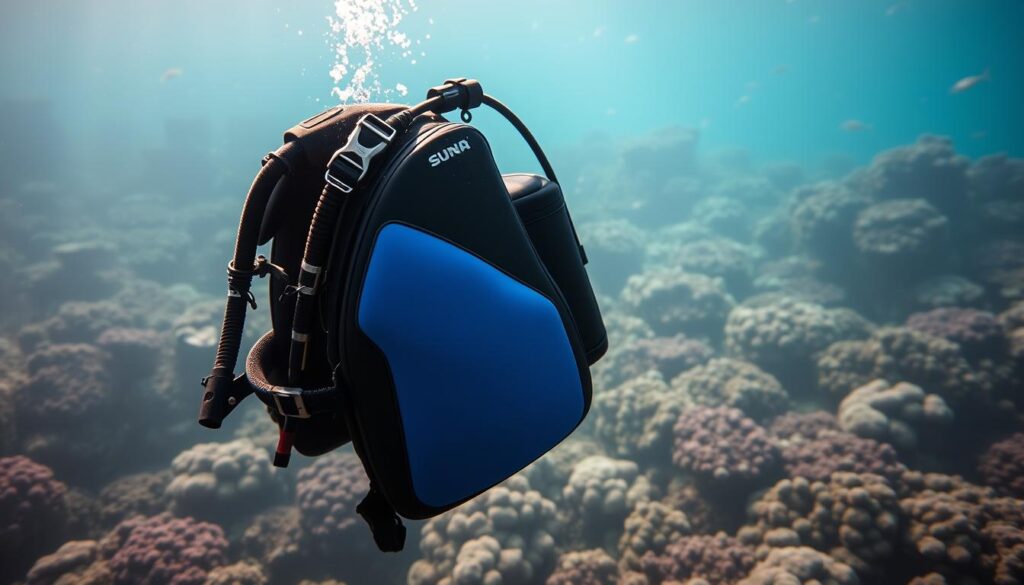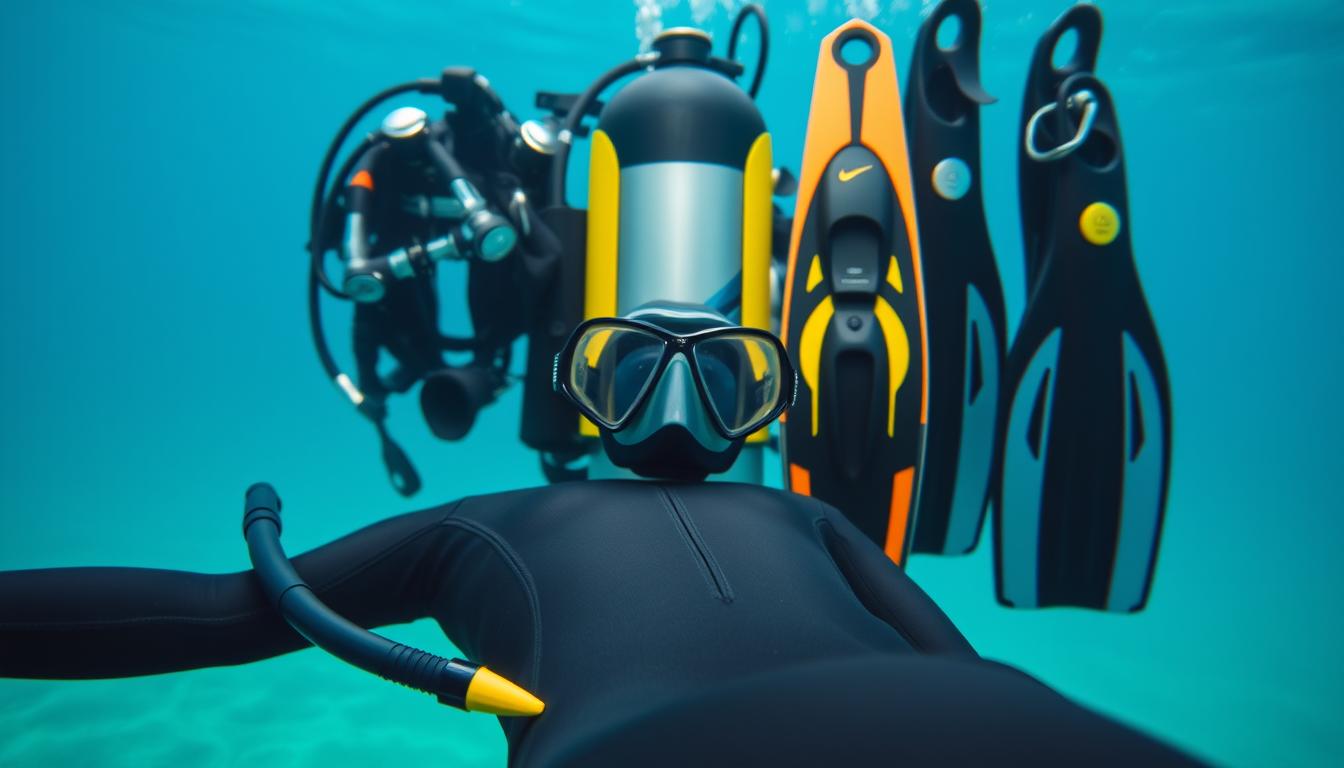Welcome to our guide on scuba diving gear, perfect for new divers and pros. Knowing the right gear is key for a safe, comfy, and great dive. It helps those diving for the first time or those diving deeper. This guide will cover all you need to know about scuba gear.
Key Takeaways
- Understanding essential scuba diving gear is crucial for safety and enjoyment.
- Choose the right dive mask to enhance visibility underwater.
- Different types of snorkels cater to various diving needs.
- Consider key features while selecting fins for better movement.
- Wetsuits are vital for temperature regulation and protection.
- Dive computers are essential for tracking dive metrics accurately.
- Regular maintenance of regulators is necessary for performance and safety.
Introduction to Essential Scuba Diving Gear
Exploring underwater is amazing but you need the right gear. Having a full scuba diving gear checklist is key. It makes diving safe and fun. Each item, from masks to dive computers, is very important.
Learning about all the scuba gear is crucial. We’ll cover the must-have items for divers:
- Dive Mask
- Snorkel
- Fins
- Wetsuit
- Dive Computer
- Regulator
- Buoyancy Control Device (BCD)
- Weight System
Using scuba diving gear tips and a good checklist helps a lot. Knowing and picking the best gear makes diving better and safer. It turns every dive into an adventure you’ll remember.
Dive Masks
It’s important to pick the right dive mask for a safe and comfy dive. There are many styles and colors, each with different benefits for your dive needs.
Top Tips for Choosing the Right Dive Mask
Make sure the dive mask fits well to stop leaks and feel comfortable. A good fit stops water from getting in and causing stress underwater. Try different masks at local dive shops to find the one that fits best.
The skirt color of the mask matters too. Clear masks bring in more light, making things look brighter and wider. Black masks keep out glare and help you focus, especially in bright or shallow water.
Here are some top brands known for quality dive masks:
- Mares
- Cressi
- Scubapro
- Aqua Lung
- Oceanic
Choosing a dive mask from a top brand that meets your needs can greatly improve your dive.
Snorkels
Snorkels are a must-have for anyone just starting to dive. They let you breathe at the surface without wasting your tank’s air. Picking the right snorkel can make your dive much better. It depends on what you need and like.
Different Types of Snorkels
Knowing the different snorkels is key to a great gear guide for diving. There are several common types:
- Dry Snorkels: These have special valves at the top that keep water out. They’re perfect if you don’t want water splashing in.
- Wet Snorkels: These are straightforward and built to last. They don’t have valves, which makes them cheap and easy to look after.
- Semi-Dry Snorkels: They mix features of dry and wet snorkels. They have a splash guard but still let you breathe easily.
Choosing your snorkel wisely is a big part of getting your diving gear right. New divers might like dry snorkels for a dry swim. People who’ve been diving a while might go for the simple wet snorkels. Either way, the right snorkel adds to your safety and comfort underwater.
Fins
Fins help you move smoothly under water. They are vital for your safety while diving. It’s important to pick the right ones to fit your diving style.
Features to Consider
Look for these when choosing fins:
- Comfort: Make sure they don’t rub or cause blisters.
- Blade Type and Material: Choose between stiff and soft blades. Your choice depends on how strong you swim and where you’ll dive.
- Weight: Light fins are best for long dives. The Avanti Quattro is a good choice.
- Style: Pick from full-foot or open-heel based on what you like. Think about if you will be snorkeling or deep diving.
The Avanti Quattro fins come highly recommended. They make diving more fun. Having the right fins is key for a great dive.
Wetsuits
Wetsuits are vital for scuba diving gear for professionals. They are needed for cold water dives. They keep a thin water layer between the skin and suit. This warms the diver. It’s key to know the different types and thicknesses when choosing a wetsuit.
The thickness of the wetsuit is key. It can range from 2mm to 5mm. Some suits combine thicknesses for warmth and flexibility. Full suits are best for water under 66°F. Shorty wetsuits work well for water around 70°F or more. They cover less body.
Wetsuits come in many styles. Choices include farmer john/jane, spring suits, and dry suits. Seams are important too. Flatlock is good for warm water. Glued seams are for cold water. Taped seams keep you warmest.
Adding booties, gloves, and hoods helps a lot. They make diving warmer and safer. Make sure the suit fits right. Too tight is not good. For tips on picking a wetsuit, visit this guide on wetsuits.
Choosing the right wetsuit is very important. It matters for comfort and safety. Think about water temp and suit thickness. Don’t forget seam types and extra gear. This helps pick the best suit for diving.
Scuba Diving Gear Guide
Diving into the ocean is exciting! But you need the right scuba diving gear. Every piece of gear has its own important role. It makes your dive fun and safe. This guide talks about all you need, whether you’re just starting or have dived a lot.
The most important gear includes dive masks and fins. A good dive mask lets you see clearly underwater. Fins help you move smoothly. Always choose these items for comfort and how long they will last.
Wetsuits keep you warm and help you float. Then, there’s the dive computer. It tracks how deep and long you’re underwater. This way, you stay safe.
You should also use a snorkel that works well with your mask. Wear a buoyancy control device (BCD) to move easily underwater. Don’t forget regulators for breathing and weight systems to keep balanced.
There are also extra gear that could help. Dive knives can be useful in emergencies. Underwater torches light up dark places. A complete gear checklist means you’re ready for anything.
Having the best scuba diving gear makes your dive way better. Keep your checklist up to date. This ensures a safe and fun adventure every time.
Dive Computers
Dive computers keep divers safe. They track dive times and profiles. It’s key to know how they work to make good choices.
Choosing the Right Dive Computer
Finding the right dive computer depends on how you dive. Top brands have lots of options. Look for features like multi-gas management, easy use, and altitude adjustments to improve dives.
A good scuba diving equipment review will talk about depth, battery, and how easy it is to read. Advanced tech connects with your other gear for safer dives.
| Feature | Description | Recommendation |
|---|---|---|
| Multi-Blend Dive Management | Allows for the use of multiple gas mixtures during a dive. | Apeks, Cressi |
| User-Friendly Interface | Intuitive design for easy navigation and readability. | Suunto, Garmin |
| Automatic Altitude Adjustment | Automatically adjusts settings based on altitude. | Shearwater, Mares |
Regulators
Regulators are key to scuba diving. They link divers to their air, letting them breathe underwater safely. Knowing about different regulators and what makes them special is key for divers.
Maintenance and Care
Keeping your diving gear in good shape is very important. If you take care of your regulator, it will work well and last a long time. Here are some tips to keep your regulator ready for dives:
- Rinsing: After diving, wash your regulator with clean water to get rid of salt and dirt.
- Inspection: Check hoses and connections often for any damage.
- Servicing: Get your regulator checked by a pro every year or as the maker suggests.
- Storage: Keep your regulator in a cool, dry spot away from the sun and heat.
| Type of Regulator | Features | Maintenance Tips |
|---|---|---|
| First-Stage Regulators | Connects to the air tank and reduces high pressure air | Ensure O-rings are lubricated and free from cracks |
| Second-Stage Regulators | Delivers air on demand to the diver | Check mouthpiece for wear and replace if necessary |
| Octopus Regulators | Serves as an emergency air source | Test function regularly to ensure reliability |
Buoyancy Control Devices (BCD)
BCDs, or Buoyancy Control Devices, are vital for any diver. They help divers stay in control underwater. This makes diving both safer and more fun. Picking the right BCD can make your dive much better.

Types of BCDs
There are many BCDs to choose from. Each one suits different diving needs. Knowing the differences helps divers pick the right scuba diving gear.
| Type of BCD | Description | Best Use |
|---|---|---|
| Jacket Style | This traditional BCD provides ample buoyancy and is perfect for recreational diving. | Beginner and recreational divers |
| Back-Inflate | Offers a streamlined fit and better trim underwater due to its back inflation design. | Experienced and technical divers |
| Wing and Harness | Provides maximum adjustability and is suitable for technical diving with multiple tanks. | Technical divers |
| Travel BCD | Lightweight and easy to pack, ideal for travel without compromising functionality. | Divers who travel frequently |
The Guardian Ergotrim model is quite popular. It fits well because it’s adjustable. It’s one of the best scuba diving gear choices. The right BCD helps with buoyancy and improves your dive. Think about your diving style and body type before choosing.
Weight Systems
In scuba diving, knowing about weight systems is key. You can choose from different types, like BCD weights or weight belts. It’s important to pick the right one to feel comfy and safe underwater.
Integrated BCD weights are a top choice for many. They fit right into the buoyancy device. This makes them easy to use. They also keep the weights securely in place, which means you won’t lose them easily.
Weight belts, however, are adjustable and flexible. You can spread the weight evenly around your waist. They let divers change the weights as needed, offering a custom fit.
Here’s a comparison of integrated BCD weights and traditional weight belts to help divers make an informed decision:
| Feature | Integrated BCD Weights | Traditional Weight Belts |
|---|---|---|
| Convenience | High | Moderate |
| Adjustability | Limited | High |
| Weight Distribution | Fixed | Flexible |
| Security | High | Moderate |
In the end, choosing the right weight system can make diving much better. Making sure beginners have the right gear is essential for a safe and comfy dive. A detailed review of equipment will help find the best choices.
Conclusion
Choosing the right scuba diving gear is key for your safety and fun underwater. This guide has shown you everything from masks to weight systems. It has shared tips to help you pick wisely. Good gear that fits you well will make your dives much better.
It’s also important to keep your gear in great shape. You should do regular checks and update your equipment. This keeps it working well and safe to use. This guide talked about caring for your gear and doing routine servicing.
The best gear really makes a difference. It keeps you safe, comfortable, and lets you dive your best. With the advice from this guide, you’re ready to enjoy the sea. You’ll feel sure and excited to dive into the underwater world.
